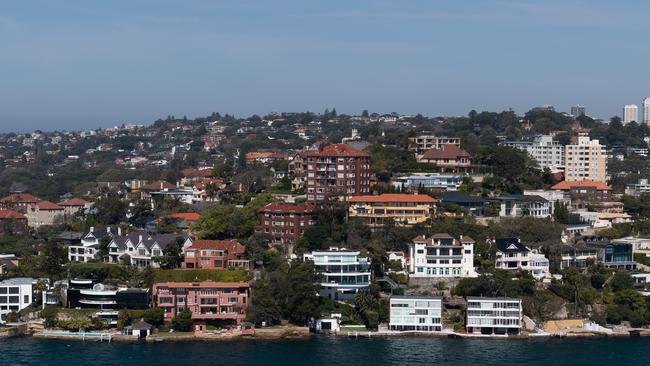ANZ forges ahead on 145 postcodes deal giving richer borrowers a leg up on loans
The controversial new ANZ policy creates three categories for low-risk mortgage borrowers in these wealthy suburbs but excludes anyone in Tasmania, SA and NT.

ANZ is shrugging off fears of rising mortgage stress to implement a controversial policy that allows wealthy customers, based in 145 postcodes including Point Piper and Toorak, to borrow up to 95 per cent of a property’s value without mortgage insurance.
The new policy, being rolled out this month, creates three distinct categories for wealthy borrowers in higher socio-economic suburbs, but excludes any postcodes in South Australia, Tasmania and Northern Territory.
ANZ began trialling the “low-risk” postcode lending initiative earlier this year with a view to assessing how eligible and wealthier borrowers would take it up and fare, sometimes with markedly larger repayments.
ANZ’s major bank rivals offer similar criteria or lending of up to 95 per cent with no lenders’ mortgage insurance (LMI) for medical professionals, but have not gone as far as releasing a home loan product based around a customer’s postcode, income level and repayment history.
The Melbourne-based bank’s policy allows borrowers within 145 postcodes – taking out a home loan of $2m or more and who meet income and other requirements – to put down a 5 per cent deposit and avoid a requirement to pay LMI. On a $2m loan the cost of LMI would set a borrower back more than $102,000, according to RateCity’s analysis of two LMI calculators.
“Eligible customers will be able to avoid the need to pay for an LMI premium, thereby reducing their required contributions towards their property purchase,” ANZ’s communication to mortgage brokers said.
ANZ also told brokers the low-risk loan product drew on customer analytics and credit bureau information.
Borrowers in ANZ’s 145 specified postcodes – including Northbridge, Bronte, Manly, Cremorne and Killara in Sydney; Brighton and Lorne in Melbourne; Hamilton in Brisbane and Cottesloe in Perth – can apply for loans of up to $4.75m under the policy, as long as they have a strong repayment history and are deemed low-risk. That includes earning an annual income exceeding about $400,000 and not being too heavily in debt on a debt-to-income ratio measure.

Above that level, ANZ provides for borrowers in a more exclusive cohort of 10 postcodes – nine of which are in NSW – to borrow up to $5.7m under the new policy, while a top threshold is whittled down to just six postcodes that can borrow up to $7.6m. The new policy covers owner-occupier mortgages, investment loans, refinancing of an existing mortgage and interest-only loans. Responding to questions on the policy an ANZ spokesman said: “ANZ considers a range of factors when we introduce or change our lending policies.
“Our standard lending process, which applies across all lending policies, includes a detailed customer review, responsible lending checks, income verification and application of the 3 per cent buffer, as well as a consideration of a customer’s repayment history.”
Banks typically assess a mortgage application by adding 3 per cent to their prevailing interest rate to assess if a borrower can afford repayments in a higher interest rate climate.
ANZ did not respond to questions about the rate pricing of the new policy, but the pilot was said to price loans in line with the market, and in some instances up to 35 basis points was added to the prevailing ANZ rate due to the loan’s customisation.
It’s an interesting time for ANZ to be pushing ahead with the policy given banks are navigating a rise in customers facing mortgage stress and divided opinions among economists about whether the Reserve Bank will lift or reduce interest rates this year.
The Council of Financial Regulators this week warned that the share of borrowers falling behind on home loan payments continued to climb alongside a rise in financial hardship applications, albeit from a low level.
MST Marquee’s banking analyst, Brian Johnson, said ANZ’s new policy was not without risk and investors would want to know how the bank would allocate capital against those loans.
“Once you get into that interest-only, high LVR-lending (loan-to-valuation ratio lending) unless you have lenders’ mortgage insurance it’s deemed to be quite a risky loan,” Mr Johnson said.
“There has to be some sort of capital arbitrage here, because as I understand the rules it shouldn’t work.”
Mr Johnson said ANZ would have to more closely monitor the diversification of its home loan book in light of the new policy to ward against any portfolio concentration.
“At the moment equity markets have been squeezed up, asset values are generally rising, which creates a disproportionate amount of wealth in the high (income) postcodes versus the lesser,” he said. “Conversely, if there was a turn in the asset value cycle it would probably be just as badly felt in the higher-income households as anywhere else.”

RateCity research director Sally Tindall said: “This seems like a deal targeting investors looking to go interest-only, where they keep as little equity in the property as possible.”
Ms Tindall said big banks “from time to time” provided LMI waivers for first-home buyers.
The ANZ policy comes as some of the big banks still have lending restrictions in place for specific postcodes, for example inner-city areas, where they may require larger deposits from borrowers.
For ANZ, the new policy is a big shift from seven years ago, when it outlined tougher lending policies for apartments in certain postcodes in Perth and Brisbane.
ANZ chief executive Shayne Elliott was also taking a cautious approach on lending to some postcodes in mining towns about two years ago, but at the time said mortgage lending was still happening, just with more due diligence by the bank.
The new policy is also counter to Mr Elliott’s prior comments around the nation’s banks having a “moral responsibility” to come up with ways that ensured home lending didn’t entrench financial inequality.
ANZ’s new policy excludes loans for construction, those involving vacant land securities, mortgages held in company or trust, or those that involve a guarantor or bridging finance.
ANZ’s interim results showed 0.79 per cent of the bank’s Australian home loan book was classified 90 days past due, a figure that included gross impaired assets.
Morgan Stanley banking analyst Richard Wiles is upbeat about credit quality at the big banks, noting they had “a conservative approach” to loan provisioning, which could be further reduced as economic growth improved.
“The average collective provision (CP) coverage has fallen from a peak of circa 1.59 per cent of credit risk-weighted-assets to 1.37 per cent currently. However, it is still 33 basis points higher than the FY19 average of circa 1.04 per cent implying an additional buffer of $4.6bn above pre-Covid levels,” he said.




To join the conversation, please log in. Don't have an account? Register
Join the conversation, you are commenting as Logout